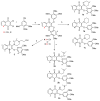Design, Synthesis and Cancer Cell Growth Inhibition Evaluation of New Aminoquinone Hybrid Molecules
- PMID: 31197105
- PMCID: PMC6630839
- DOI: 10.3390/molecules24122224
Design, Synthesis and Cancer Cell Growth Inhibition Evaluation of New Aminoquinone Hybrid Molecules
Abstract
Molecular hybridization has proven to be a successful multi-target strategy in the design and development of new antitumor agents. Based on this rational approach, we have planned hybrid molecules containing covalently linked pharmacophoric units, present individually in compounds acting as inhibitors of the cancer protein targets tubulin, human topoisomerase II and ROCK1. Seven new molecules, selected by docking calculation of the complexes with each of the proteins taken into consideration, have been efficiently synthesized starting from 2,3-dichloro-1,4-naphtoquinone or 6,7-dichloro-5,8-quinolinquinone. By screening the full National Cancer Institute (NCI) panel, including 60 human cancer cell lines, four molecules displayed good and sometimes better growth inhibition GI50 than the ROCK inhibitor Y-27632, the Topo II inhibitor podophyllotoxin and the tubulin inhibitor combretastatin A-4. The relative position of N,N heteroatoms in the structures of the tested compounds was crucial in affecting bioactivity and selectivity. Furthermore, compound 3 (2-(4-(2-hydroxyethyl)piperazin-1-yl)-3-(3,4,5-trimethoxyphenoxy)naphthalene-1,4-dione) emerged as the most active in the series, showing a potent and selective inhibition of breast cancer BT-549 cells (GI50 < 10 nM).
Keywords: 3,4,5-trimethoxyphenyl group; antitumor activity; cytotoxicity; docking calculation; hybrid molecules; naphtoquinones; quinolinequinones.
Conflict of interest statement
The authors declare no conflict of interest.
Figures



Similar articles
-
Synthesis, anticancer activity and molecular docking studies on a series of heterocyclic trans-cyanocombretastatin analogues as antitubulin agents.Eur J Med Chem. 2015 Mar 6;92:212-20. doi: 10.1016/j.ejmech.2014.12.050. Epub 2014 Dec 29. Eur J Med Chem. 2015. PMID: 25557492 Free PMC article.
-
Insights into podophyllotoxin lactone features: New cyclolignans as potential dual tubulin-topoisomerase II inhibitors.Arch Pharm (Weinheim). 2025 Jan;358(1):e2400600. doi: 10.1002/ardp.202400600. Epub 2024 Nov 12. Arch Pharm (Weinheim). 2025. PMID: 39533473 Free PMC article.
-
Synthesis of podophyllotoxin linked β-carboline congeners as potential anticancer agents and DNA topoisomerase II inhibitors.Eur J Med Chem. 2018 Jan 20;144:557-571. doi: 10.1016/j.ejmech.2017.12.055. Epub 2017 Dec 16. Eur J Med Chem. 2018. PMID: 29289881
-
Dual Inhibitors of Human DNA Topoisomerase II and Other Cancer-Related Targets.J Med Chem. 2020 Feb 13;63(3):884-904. doi: 10.1021/acs.jmedchem.9b00726. Epub 2019 Oct 21. J Med Chem. 2020. PMID: 31592646 Review.
-
Dual-targeting inhibitors involving tubulin for the treatment of cancer.Bioorg Chem. 2025 Mar;156:108116. doi: 10.1016/j.bioorg.2024.108116. Epub 2024 Dec 30. Bioorg Chem. 2025. PMID: 39823818 Review.
Cited by
-
Design, Synthesis, Physicochemical Properties, and Biological Activity of Thymidine Compounds Attached to 5,8-Quinolinedione Derivatives as Potent DT-Diaphorase Substrates.Int J Mol Sci. 2024 Oct 18;25(20):11211. doi: 10.3390/ijms252011211. Int J Mol Sci. 2024. PMID: 39456992 Free PMC article.
-
Hybrid Molecules Containing Naphthoquinone and Quinolinedione Scaffolds as Antineoplastic Agents.Molecules. 2022 Aug 3;27(15):4948. doi: 10.3390/molecules27154948. Molecules. 2022. PMID: 35956896 Free PMC article. Review.
-
Design and Synthesis of Organic Molecules as Antineoplastic Agents.Molecules. 2020 Jun 18;25(12):2808. doi: 10.3390/molecules25122808. Molecules. 2020. PMID: 32570759 Free PMC article.
-
Exploring the Anticancer Effects of Brominated Plastoquinone Analogs with Promising Cytotoxic Activity in MCF-7 Breast Cancer Cells via Cell Cycle Arrest and Oxidative Stress Induction.Pharmaceuticals (Basel). 2022 Jun 22;15(7):777. doi: 10.3390/ph15070777. Pharmaceuticals (Basel). 2022. PMID: 35890076 Free PMC article.
-
Structure modification of luteolin and the influence of its derivatives on biological activities.Front Nutr. 2025 Mar 12;12:1546932. doi: 10.3389/fnut.2025.1546932. eCollection 2025. Front Nutr. 2025. PMID: 40144571 Free PMC article.
References
-
- Abbot V., Sharma P., Dhiman S., Noolvi M.N., Patel H.M., Bhardwaj V. Small hybrid heteroaromatics: Resourceful biological tools in cancer research. RSC Adv. 2017;7:28313–28349. doi: 10.1039/C6RA24662A. - DOI
MeSH terms
Substances
LinkOut - more resources
Full Text Sources

